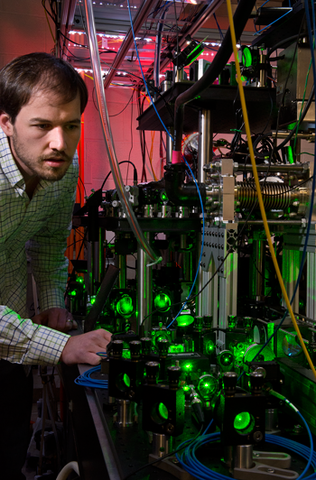
JQI researcher Creston Herold examines part of the experimental apparatus.
Scientists from a PML-Joint Quantum Institute (JQI)* group have devised and demonstrated a novel method** for making the most precise measurements to date of the properties of two atomic transitions ("quantum leaps") in rubidium – an element whose transitions are used as frequency standards for many atomic clocks, Global Positioning System satellites, and telecommunications systems. The technique is accurate to about 0.3%, which is 10 times more accurate than the best theoretical values.
Atomic clocks work by detecting the precise frequency that causes an atom to oscillate between two discrete quantum states, and then tuning the clock's timing signal so that it exactly matches that frequency. But the energy differences in those transitions – and hence the frequencies that prompt the transitions – are affected by any electromagnetic radiation, including the inescapable blackbody radiation that is present even in an ultracold atomic clock. This effect, called the "light shift," is an important source of uncertainty in atomic clocks because it is extremely difficult to quantify experimentally.
The NIST-JQI team, which also includes a colleague from the University of Delaware, found a way around the problem by taking advantage of a quantum phenomenon in which all the light-shifts in atoms irradiated with certain precise wavelengths cancel each other out. In that condition, the atoms no longer "feel" the light.
By measuring these "magic zero" wavelengths with unprecedented accuracy, the scientists were able to place tight constraints on the factors that determine the strength of the light shifts that affect two different transitions in rubidium. The technique can provide much-needed data for other atomic-clock elements, including mercury, strontium and ytterbium.
"One of the trends in physics is the relentless pursuit of higher precision, which helps uncover hidden surprises as well as advancing technology," says JQI Co-Director Steve Rolston, a member of the research group. "This work adds to our toolbox of precision atomic physics techniques."
For a full, illustrated description of the experiment, see the report on the JQI's website.
* The Joint Quantum Institute is a research partnership between NIST and the University of Maryland, with the support and participation of the Laboratory for Physical Sciences.
** "Precision Measurement of Transition Matrix Elements via Light Shift Cancellation," C. D. Herold, V. D. Vaidya, X. Li, S. L. Rolston, J. V. Porto, M. S. Safronova, forthcoming in Physical Review Letters.

